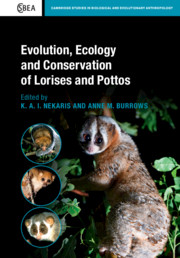Book contents
- Evolution, Ecology and Conservation of Lorises and Pottos
- Cambridge Studies in Biological and Evolutionary Anthropology
- Evolution, Ecology and Conservation of Lorises and Pottos
- Copyright page
- Dedication
- Contents
- Contributors
- Foreword
- Acknowledgements
- 1 Introduction
- Part I Evolution, Morphology and the Fossil Record
- Part II Ecology and Captive Management
- 13 Nutrition of Lorisiformes
- 14 Seeing in the Dark
- 15 Thermoregulation in Lorises
- 16 Home Range, Activity Budgets and Habitat Use in the Bengal Slow Loris (Nycticebus bengalensis) in Bangladesh
- 17 Behaviour of Pottos and Angwantibos
- 18 Positional Behaviour and Substrate Preference of Slow Lorises, with a Case Study of Nycticebus bengalensis in Northeast India
- 19 Sexual Differences in Feeding and Foraging of Released Philippine Slow Loris (Nycticebus menagensis)
- 20 Ranging Patterns of the Pygmy Slow Loris (Nycticebus pygmaeus) in a Mixed Deciduous Forest in Eastern Cambodia
- 21 Utilising Current and Historical Zoo Records to Provide an Insight into the Captive Biology of the Rarely Kept Species Pottos and Angwantibos
- 22 Mother–Infant Behaviours in Greater Slow Loris (Nycticebus coucang) Dyads Consisting of Mothers Pregnant at Confiscation and Their Sanctuary-Born Infants
- 23 Husbandry and Reproductive Management Recommendations for Captive Lorises and Pottos (Nycticebus, Loris and Perodicticus)
- Part III Research, Trade and Conservation
- References
- Index
13 - Nutrition of Lorisiformes
from Part II - Ecology and Captive Management
Published online by Cambridge University Press: 29 February 2020
- Evolution, Ecology and Conservation of Lorises and Pottos
- Cambridge Studies in Biological and Evolutionary Anthropology
- Evolution, Ecology and Conservation of Lorises and Pottos
- Copyright page
- Dedication
- Contents
- Contributors
- Foreword
- Acknowledgements
- 1 Introduction
- Part I Evolution, Morphology and the Fossil Record
- Part II Ecology and Captive Management
- 13 Nutrition of Lorisiformes
- 14 Seeing in the Dark
- 15 Thermoregulation in Lorises
- 16 Home Range, Activity Budgets and Habitat Use in the Bengal Slow Loris (Nycticebus bengalensis) in Bangladesh
- 17 Behaviour of Pottos and Angwantibos
- 18 Positional Behaviour and Substrate Preference of Slow Lorises, with a Case Study of Nycticebus bengalensis in Northeast India
- 19 Sexual Differences in Feeding and Foraging of Released Philippine Slow Loris (Nycticebus menagensis)
- 20 Ranging Patterns of the Pygmy Slow Loris (Nycticebus pygmaeus) in a Mixed Deciduous Forest in Eastern Cambodia
- 21 Utilising Current and Historical Zoo Records to Provide an Insight into the Captive Biology of the Rarely Kept Species Pottos and Angwantibos
- 22 Mother–Infant Behaviours in Greater Slow Loris (Nycticebus coucang) Dyads Consisting of Mothers Pregnant at Confiscation and Their Sanctuary-Born Infants
- 23 Husbandry and Reproductive Management Recommendations for Captive Lorises and Pottos (Nycticebus, Loris and Perodicticus)
- Part III Research, Trade and Conservation
- References
- Index
Summary
For many wild animals under human care, detailed nutritional requirements are not yet established. In these cases, we must use the existing knowledge of domestic species as models. The nearest model to lorisiforms is the common marmoset Callithrix jacchus, which is not a domestic species but has been used in laboratories since the 1970s and its nutritional requirements have been well described (NRC, 2003). Unfortunately, the marmoset is not a perfect model because of its differing basal metabolic rates (Ross, 1992), high vitamin D requirements (Abbott et al., 2003) and differing proportions of food items within its natural diets (Cabana et al., 2018b). Therefore, many parameters must be estimated based on the wild loris’ feeding ecology and feeding trials under human care (Baer et al., 2010). The stakes are much higher today, since we know that diets are not only responsible for supplying optimal concentrations of nutritional components, but also for supporting the animal’s welfare through appropriate food presentation methods (Scott et al., 1999). Providing more natural diets may help in doing the latter, but it does not guarantee a balanced diet. Even a diet consisting entirely of insects is not necessarily nutritionally appropriate for insectivorous animals as the insects commonly fed in captivity such as mealworms and crickets lack many micronutrients (Finke, 2013).
- Type
- Chapter
- Information
- Evolution, Ecology and Conservation of Lorises and Pottos , pp. 165 - 173Publisher: Cambridge University PressPrint publication year: 2020



